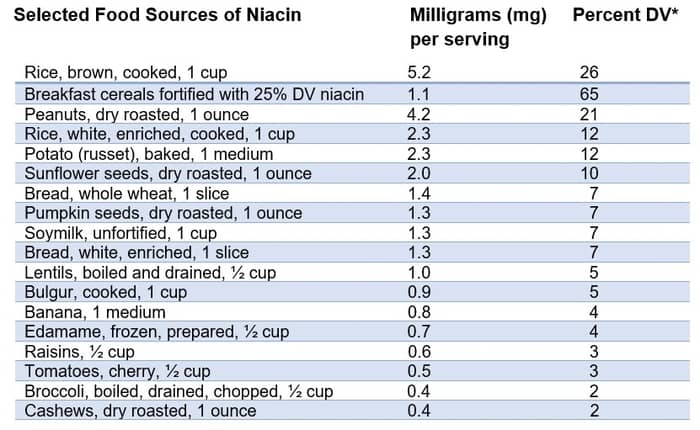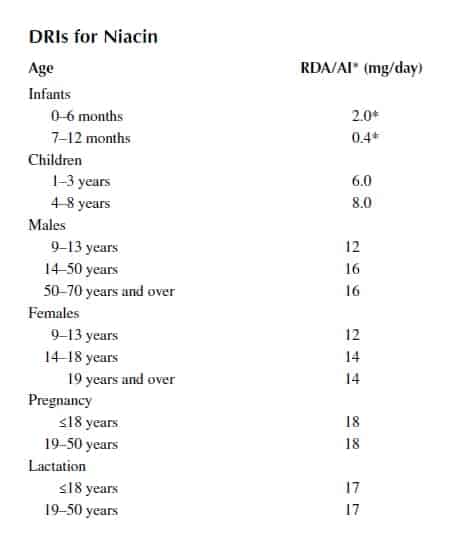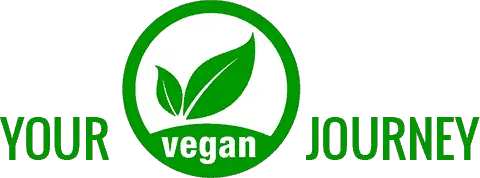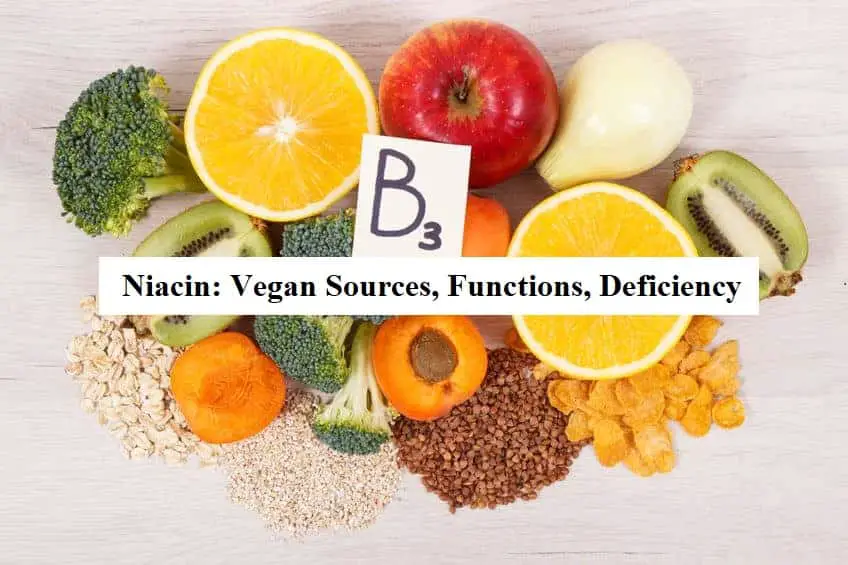Continuing with the B vitamins, it’s time to cover some basic information about vitamin B3 or niacin as relates to plant-based eating.
First, I’ll answer some common questions for those of you who are in a rush:
- Is niacin (B2) vegan? Yes, unlike vitamin D (check out the article here), niacin is present in a wide variety of foods, including many plants.1 As for supplements, niacin can be derived from animals but tends to be produced chemically and microbially.20 So, it’s typically considered vegan.
- Are niacin supplements vegan? Yes, typically. Most are produced synthetically or by microbes.
- What are some vegan niacin sources? Common vegan sources of niacin include rice, peanuts, potatoes, and sunflower seeds.1 (See the chart below for more examples)
- Are vegans at risk for niacin deficiency? No, not characteristically. According to the NIH, those at risk for niacin deficiency include people with undernutrition, Hartnup disease, carcinoid syndrome, and inadequate intake of riboflavin, pyridoxine, and/or iron.1
What we’ll do here is take a closer look at niacin sources as well as some other basic info. As with thiamin, we’ll cover its functions and the unique ways (if any) in which a vegan diet could lead to deficiency.
Overview and Functions
Niacin is one of the water-soluble vitamins. Like many other nutrients, it was discovered through its deficiency disorder, in this case, a condition known as pellagra in humans.
Deficiency in dogs led to a similar condition known as black tongue, and as a result, the vitamin was once referred to as anti-black tongue factor.
Pellagra was once especially common to the southeastern US where corn (a regional grain that was a main staple in the early 1900s) contained a relatively unavailable form of the vitamin.
To prevent confusion, vitamin B3 is niacin which is a term for two distinct, but similar compounds that have the same vitamin activity: nicotinic acid and nicotinamide (aka niacinamide).
For chemistry geeks, nicotinic acid is structurally a pyridine 3-carboxylic acid, while nicotinamide is nicotinic acid amide.
Niacin is usually found as nicotinamide in supplements but takes a variety of forms in food.
In plant foods, it occurs mainly as nicotinic acid, while in animal foods it’s present mainly as nicotinamide, nicotinamide adenine dinucleotide (NAD) and nicotinamide adenine dinucleotide phosphate (NADP).2
Niacin (in either form) can be used by the body to make the two active coenzymes NAD and NADP which go on to play various roles some of which involve macronutrients.
These two coenzymes serve several functions in the body—more than I’ll list here—but below are its primary roles.
Redox Roles
Energy Transformation: NAD
Like thiamin and riboflavin, niacin is important in deriving energy from macronutrients. Specifically, it’s involved in:3
- Glycolysis
- Krebs cycle
- Electron transport chain
- Breakdown of fatty acids
Fat Metabolism: NADP
While NAD breaks down nutrients for energy, NADPH serves as a reducing agent, carrying electrons in several biosynthetic processes such as fatty acid and cholesterol synthesis.
Other Redox Roles
- Ethanol metabolism (NAD)
- Proline synthesis (NADP)
- Vitamin B6 metabolism (NAD)
- Synthesis of the DNA precursor, deoxyribonucleotide (NADP)
- Regeneration of vitamin C and glutathione
- Synthesis of a folate coenzyme
Non-Redox: NAD
NAD is involved in the modification of proteins associated with chromosomes as well as reactions that control cellular processes like DNA repair, replication, and transcription, among other things.4-6
Vegan Sources of Niacin
Higher Bioavailability
Grains and Grain Products
Appreciable amounts of niacin can be found in:
- Enriched and fortified bread products and cereals—enriched white bread and white rice have around 1.1 mg per slice and 3.5 mg of niacin per ½ cup, respectively.7,8
- Whole grains—1 slice of multigrain bread has 1.1 mg of niacin. 1 cup of Cheerios® provides about 5 mg of niacin which is 25% of the DV (20 mg).9,10
- Seeds—an ounce of sesame seeds has 1.3 mg or 6% DV.11
Peanuts
You can find niacin in decent amounts in various legumes, and peanuts are a particularly good source. In fact, 2 Tbsp. of peanut butter has 4.3 mg of niacin or 21% DV.
Lesser Bioavailability
Coffee and Tea
Niacin is found in varying amounts in coffee and tea.
Some are preformed while other niacin may be formed via processing. For example, in coffee, there’s a compound called trigonelline which is converted to niacin via heat (coffee bean roasting) and acid.
Peptides and Complex Carbohydrates
Above I mentioned NAD, NADP, nicotinic acid, and nicotinamide to be the primary forms of niacin in foods. Well, in addition to these, niacin may be present in a couple of bound forms:
- Niacytin—when niacin is covalently bound to complex carbohydrates
- Niacinogens—niacin bound to small peptides
Bound niacin is found primarily in corn, wheat, and cereal products. And yes, these forms aren’t very bioavailable—hence, the prevalence of niacin deficiency in the olden days. It’s thought that only around 10% of the niacin from corn is available for absorption.
As it turns out, chemical treatment with bases like lime water improves the availability of some bound niacin, as does exposure to gastric acid.
Tryptophan Containing Foods
And, for the reasons outlined below (the RDA section), tryptophan-containing foods can be considered sources of niacin, as the vitamin can be synthesized in the liver and other tissues from this amino acid.
Select Vegan Sources of Niacin

The daily value for niacin by which the above values were derived is 20 mg for adults and kids age 4 and older.12
This DV, however, is changing to 16 mg NE per the updated Nutrition and Supplement Facts labels .13
The updated DVs and labels must appear on dietary supplements and food products starting January 2020, but they can be used now.12
FDA doesn’t actually require labels to list niacin unless a food has been fortified with it. High sources of a nutrient are those providing 20% DV or more, but foods providing less also contribute to a healthy diet.
The U.S. Department of Agriculture’s (USDA’s) National Nutrient Database for Standard Reference external link disclaimer website has a comprehensive list of foods with their nutrient content (including niacin) organized by food name and nutrient content.14
Vegan Niacin Needs
Experts decided to make this way more complicated, so if you’re not a nutrition nerd, you may want to skip ahead to the chart. Nutrition facts panels only list preformed niacin, so that’s really the only thing you’ll probably ever pay attention to.
But, if you feel like making life harder, you can always look at the products protein content to know whether you can count what are known as niacin equivalents. You see, niacin is made from tryptophan, and it’s estimated that about 60 mg of tryptophan generate around 1 mg of niacin.
And yes, official recommendations take this into account.
So, if you ever see the term niacin equivalent (NE) it’s there to account for the provision of niacin by tryptophan, where 60 mg of tryptophan = 1 mg of NE. Vitamin A and folate use a similar convention.
If you’re wondering how it is someone is supposed to know the amount of tryptophan in a given food, keep in mind that only high-quality protein counts in determining niacin equivalents. It’s assumed that 10 mg of tryptophan is provided for each gram of high-quality (complete) protein.
So, if you happen to know that a given source of protein is high-quality (which we do), you can infer niacin equivalents from there. For example:
- Each gram of protein = 10 mg of tryptophan
- There’s 60 g high-quality protein in a given food which provides 600 mg of tryptophan
- We know it takes 60 mg of tryptophan to generate 1 mg of NE, therefore, we know the snack provides 10 NEs.
And yeah, you’ll probably never need that. I like to think of tryptophan as a nice bonus, or vitamin B3 insurance. And tryptophan does go a long way in helping people meet their needs. On average, the U.S. diet contains about 900 mg of tryptophan daily, and the US gets about 50% of its niacin intake from this amino acid.15
Estimates of niacin requirements and recommendations come from info including depletion and repletion studies, and urinary niacin metabolites which together serve as indicators of basic requirements.
The RDAs for adult men and women are 16 mg and 14 mg of niacin equivalents per day, respectively.16
With pregnancy and lactation, the RDA for niacin increases to 17 mg per day.16

Source: Micronutrients in Health and Disease. Kedar Prasad – Crc – 2011
Deficiency Symptoms
Niacin deficiency results in the condition pellagra—pelle meaning “skin” and agra meaning “rough” in Italian.
Look out for the Four D’s of Pellagra
- Dermatitis
- Dementia
- Diarrhea
- Death
Looking out for the fourth one may be a stretch, but you get the idea.
Anyway, this is an old mnemonic device to help folks remember the signs.
Dermatitis, in this case, is similar to sunburn at least at first. It’s similar to sunburn in that it appears on areas exposed to the sun, such as the neck, face, and extremities like the elbows, wrists, backs of the hands, knees, and feet.
The presence of dermatitis on the neck is often called Casal’s collar or necklace.
The neurological manifestations of pellagra include
- Headache
- Memory loss
- Apathy
- Paralysis of extremities
- Peripheral neuritis
- Confusion and disorientation
- Dementia or delirium
GI manifestations include
- Angular stomatitis (sores at the corners of the mouth)
- Glossitis (inflammation of the tongue)
- Cheilosis
- Diarrhea
- Nausea and vomiting
If left untreated, death can occur, hence the fourth D.
The Vegan Diet and Niacin Status
Thankfully, niacin deficiency isn’t a huge issue for vegans.
The vitamin is fairly widely distributed among plant-based foods like grains, nuts, and legumes, which provide about 2-5 mg niacin per serving, mainly in the available form of nicotinic acid.
Yes, niacin present in some grain products is largely bound to complex carbs and peptides that are only 30% bioavailable.17,18
However, the US and many other countries have niacin added to many cereals and breads. Moreover, the niacin that’s added to fortified and enriched foods is in its free form and thus highly bioavailable.19
References
- Office Of Dietary Supplements – Niacin https://ods.od.nih.gov/factsheets/Niacin-HealthProfessional/
- Gropper, Sareen S.; Smith, Jack L.. Advanced Nutrition and Human Metabolism (Page 330).
- Gropper, Sareen S.; Smith, Jack L.. Advanced Nutrition and Human Metabolism (Page 332).
- Kirkland JB. Poly ADP-ribose polymerase-1 and health. Exp Biol Med. 2010; 235:561–68.
- Corda D, DiGirolamo M. Functional aspects of protein mono-ADPribosylation. EMBO J. 2003; 22:1953–58.
- Kirkland JB. Niacin status impacts chromatin structure. J Nutr. 2009; 139:2397–2401.
- Bread, White, Commercially Prepared (includes Soft Bread Crumbs) Nutrition Facts & Calories https://nutritiondata.self.com/facts/baked-products/4872/2
- Rice, White, Long-grain, Regular, Raw, Enriched Nutrition Facts & Calories https://nutritiondata.self.com/facts/cereal-grains-and-pasta/5711/2
- Bread, Multi-grain (includes Whole-grain) Nutrition Facts & Calories https://nutritiondata.self.com/facts/baked-products/4846/2
- Cereals Ready-to-eat, General Mills, Cheerios Nutrition Facts & Calories https://nutritiondata.self.com/facts/breakfast-cereals/1522/2
- Seeds, Sesame Seeds, Whole, Dried Nutrition Facts & Calories https://nutritiondata.self.com/facts/nut-and-seed-products/3070/2
- U.S. Food and Drug Administration. Food Labeling: Revision of the Nutrition and Supplement Facts Labels and Serving Sizes of Foods That Can Reasonably Be Consumed at One Eating Occasion; Dual-Column Labeling; Updating, Modifying, and Establishing Certain Reference Amounts Customarily Consumed; Serving Size for Breath Mints; and Technical Amendments; Proposed Extension of Compliance Datesexternal link disclaimer. 2017.
- U.S. Food and Drug Administration. Food Labeling: Revision of the Nutrition and Supplement Facts Labels.external link disclaimer 2016.
- U.S. Department of Agriculture, Agricultural Research Service. USDA National Nutrient Database for Standard Reference, Release 27. Nutrient Data Laboratory Home Page, 2014.
- Food and Nutrition Board. Dietary Reference Intakes for Energy, Carbohydrates, Fiber, Fat, Protein and Amino Acids. Washington, DC: National Academy Press. 2002.
- Food and Nutrition Board. Dietary Reference Intakes for Thiamin, Riboflavin, Niacin, Vitamin B6, Folate, Vitamin B12, Pantothenic Acid, Biotin, and Choline. Washington, DC: National Academy Press. 1998 pp. 123–49.
- Kirkland JB. Niacin. In: Ross AC, Caballero B, Cousins RJ, Tucker KL, Ziegler TR, eds. Modern Nutrition in Health and Disease, 11th ed. Baltimore, MD: Williams & Wilkins; 2014:331-40.
- Bourgeois C, Moss J. Niacin. In: Coates PM, Betz JM, Blackman MR, Cragg GM, Levine M, Moss J, White JD, eds. Encyclopedia of Dietary Supplements, 2nd ed. New York, NY: Informa Healthcare; 2010:562-9.
- Institute of Medicine. Food and Nutrition Board. Dietary Reference Intakes: Thiamin, Riboflavin, Niacin, Vitamin B6, Folate, Vitamin B12, Pantothenic Acid, Biotin, and Choline. Washington, DC: National Academy Press, 1998.
- Jose L. Revuelta, Ruben M. Buey, Rodrigo Ledesma‐Amaro, and Erick J. Microbial biotechnology for the synthesis of (pro)vitamins, biopigments and antioxidants: challenges and opportunities. Microb Biotechnol. 2016 Sep; 9(5): 564–567.

